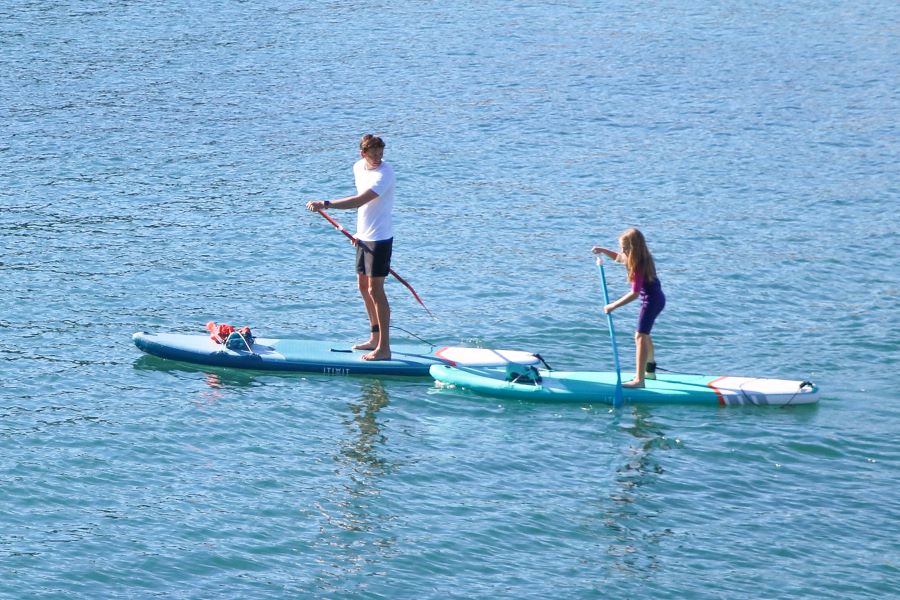
Introduce Your Child To Stand-Up Paddle Boarding
Share
As an avid stand-up paddleboarder and parent, your little one has probably already seen you paddle board and like most kids have asked “can I come?”. Introducing your child to stand-up paddle boarding can be a fantastic experience. It gives you another fun activity to do together and as a parent, it’s always a great feeling to share your passions and hobbies with your child.
Our handy guide explains how to get your child started on a stand-up paddle board. Following our tips and tricks will help you to make sure they have the best possible experience.
How Do You Know When Your Child Is Ready For Stand-Up Paddle Boarding?
It’s important to make sure children are ready to take on the challenge of stand-up paddle boarding before putting them on a board. Children must be able to swim and should have adequate control of their movements, typically around the age of five. You should also make sure they have the proper safety equipment and sun protection (more on this later).
Rather than sending them out on their own board, doubling up can be a good way to gently introduce them to the sport. This will allow them to become familiar with the water, observe your technique up close, and experience the amazing feeling of gliding through the water. From this position, you can even help them to try to stand up.
How To Get On A Stand Up Paddle Board With Two People
Step 1: Choose the Right Spot
As having another person, even a small one, on your board requires more balance so you’ll need to pick a calm, quiet spot to launch your board. Lakes and ponds can be ideal for this as the water is usually flat. You’ll also want to make sure the water isn’t too cold and the weather is warm enough for an enjoyable experience.
Step 2: Put Your Child on the Board
It’s much easier to start by placing your child on the board. Trying to get them aboard when you’re already on it can be nearly impossible. Instead, start with them sitting on the board in a kneeling position. Once they’re on the board, allow them some time to become familiar and comfortable with the board. Next, move them into the correct position. They should be positioned in the centre of the board, just in front of where you’d normally stand.
Step 3: Climb Aboard the Stand-Up Paddle Board
Once your child is firmly seated, you can now climb aboard. You can do this by climbing on from the back and then moving forward to just behind your child. Start paddling from a kneeling position to help you get a feel for the balance -- it’s slightly different and harder to balance with two people on the board.
Step 4: Find Your Balance Point
Before you stand up on the board, it’s essential to gain the proper balance. Each board is slightly different so you may need to experiment a bit to find the perfect position. On most boards, the balance point will be slightly behind where you’d normally stand as to accommodate the extra weight of your child.
Step 5: Stand Up
Now that you’ve found the balance point, you can start to move into a standing position. Try to keep your weight centered as you push up to the standing position, a very similar movement to how you’d normally stand up on the board. After you’ve gained your feet, you can start to paddle.
Must-Have Stand-Up Paddle Board Gear
Buoyancy Aids. It’s important to make sure your little one is safe when learning to stand-up paddle board. Even if they’re a good swimmer, a buoyancy aid will keep them safe when they fall into the water. Make sure your child is using the correct buoyancy aid for their weight and its used correctly. (Currently available in-store only).
Stand-up Paddle Board. Your current SUP board might not be big enough to accommodate two people. An inflatable stand-up paddle board designed for beginners typically have enough space for two and are easier to maneuver, essential when you’re trying to balance with two.
Stand-up Paddle Board Leash. When you’re learning to balance with two people, it’s likely that you may take a few tumbles -- a paddle board leash guarantees that your board never gets too far away from you. (Included with Decathlon SUPs)
Wetsuit. Your little one may be spending quite a lot of time in the water and UK water temperatures can be rather chilly. A kids wetsuit can help keep them warm, allowing you to spend more time practicing stand-up paddle boarding.
Paddle. You’ll need a to make sure you can confidently move around the water. Investing in an adjustable paddle might be a good idea as you can adjust it to your child’s proper height to allow them to safely practice paddling.
Now that you’ve got the right gear, it’s time to introduce your child to the wonderful sport of stand-up paddle boarding. We wish you and your family the best first SUP experience!















